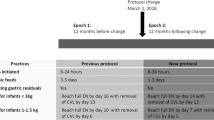Abstract
Nutrient-enriched diets for preterm infants after hospital discharge (preterm formula or postdischarge formula (PDF)) results in improved growth and these differences appear to persist beyond the period of nutrient intervention. The PDF diet effect is greatest in males, possibly reflecting their higher growth rates. The critical growth epoch appears to be the first 2 months post-term, suggesting a finite period and therefore opportunity for enhanced growth. Whether the observed growth effects persist further or have consequences for other aspects of health or development requires further investigation.
This is a preview of subscription content, access via your institution
Access options
Subscribe to this journal
Receive 12 print issues and online access
$259.00 per year
only $21.58 per issue
Buy this article
- Purchase on Springer Link
- Instant access to full article PDF
Prices may be subject to local taxes which are calculated during checkout

Similar content being viewed by others
References
American Academy of Pediatrics, Committee on Nutrition. Nutritional needs of preterm infants. In: Kleinman RE (ed.), Pediatric Nutrition Handbook. 4th edn. American Academy of Pediatrics: Elk Grove Village, IL, 1998, pp. 55–87.
Radmacher PG, Looney SW, Rafail ST, Adamkin DH . Prediction of extrauterine growth retardation (EUGR) in VVLBW infants. J Perinatol 2003; 23: 392–395.
Ehrenkranz RA, Younes N, Lemons JA, Fanaroff AA, Donovan EF, Wright LL et al. Longitudinal growth of hospitalized very low birth weight infants. Pediatrics 1999; 104: 280–289.
Wilson DC, Cairns P, Halliday HL, Reid M, McClure G, Dodge JA . Randomized controlled trial of an aggressive nutritional regimen in sick very low birthweight infants. Arch Dis Child Fetal Neonatal Ed 1997; 77: F4–F11.
Pauls J, Bauer K, Versmold H . Postnatal body weight curves for infants below 1000 g birth weight receiving early enteral and parenteral nutrition. Eur J Pediatr 1998; 157: 416–421.
Widdowson EM . Changes in body proportions and composition during growth. In: Davis JA, Dobbing J (eds.) Scientific Foundations of Pediatrics. WB Saunders Co: Philadelphia, 1974, pp. 153–163.
Bishop NJ, King FJ, Lucas A . Increased bone mineral content of preterm infants fed with a nutrient enriched formula after discharge from hospital. Arch Dis Child 1993; 68: 573–578.
Cooke RJ, Griffin IJ, McCormick K, Wells JC, Smith JS, Robinson SJ et al. Feeding preterm infants after hospital discharge: effect of dietary manipulation on nutrient intake and growth. Pediatr Res 1998; 43: 355–360.
Lucas A, Brooke OG, Morley R, Cole TJ, Bamford MF . Early diet of preterm infants and development of allergic or atopic disease: randomized prospective study. Br Med J 1990; 300: 837–840.
Lucas A, Morley R, Cole TJ . Randomized trial of early diet in preterm babies and later intelligence quotient. Br Med J 1998; 317: 1481–1487.
Fewtrell MS, Prentice A, Jones Sc, Bishop NJ, Stirling D, Buffenstein R et al. Bone mineralization and turnover in preterm infants at 8–12 years of age: the effect of early diet. J Bone Miner Res 1999; 14: 810–820.
Hack M, Merkaatz IR, Gordon D, Jones PK, Fanaroff AA . The prognostic significance of postnatal growth in very low-birth weight infants. Am J Obstet Gynecol 1982; 143: 693–699.
Lucas A, Gore SM, Cole TJ, Bamford MF, Dossetor JF, Barr I et al. Multicentre trial on feeding low birth weight infants: effects of diet on early growth. Arch Dis Child 1984; 59: 722–730.
Morley R, Lucas A . Randomized diet in the neonatal period and growth performance until 7.5–8 y of age in preterm children. Am J Clin Nutr 2000; 107: 270–273.
Lucas A, Bishop NJ, King FJ, Cole TJ . Randomized trial of nutrition for preterm infant after discharge. Arch Dis Child. 1992; 67: 324–327.
Carver JD, Wu PYK, Hall RT, Ziegler EE, Sosa R, Jacobs J et al. Growth of preterm infants fed nutrient-enriched or term formula after hospital discharge. Pediatrics 2001; 107: 683–689.
Lucas A, Fewtrell MS, Morley R, Singhal A, Abbott RA, Isaacs E et al. Randomized trial of nutrient-enriched formula versus standard formula for postdischarge preterm infants. Pediatrics 2001; 108: 703–711.
Cooke RJ, Embleton ND, Griffin IJ, Wells JC, McCormick KP . Feeding preterm infants after hospital discharge: growth and development at 18 months of age. Pediatr Res 2001; 49: 719–722.
Cooke RJ, McCormick K, Griffin IJ, Embleton N, Faulkner K, Wells JC et al. Feeding preterm infants after hospital discharge: effect of diet on body composition. Pediatr Res 1999; 46: 461–464.
De Curtis M, Pieltain C, Rigo J . Body composition in preterm infants fed standard term or enriched formula after hospital discharge. Eur J Nutr 2002; 41: 177–182.
Henderson G, Fahey T, McGuire W . Calorie and protein-enriched formula versus standard term formula for improving growth and development in preterm or low birthweight infants following hospital discharge (Review). The Cochrane Database of Systematic Reviews, Vol. 4, 2005, 22pp.
Litmanovitz I, Dolfin T, Arnon S, Bauer S, Regev R, Shainkin-Kestenbaum R et al. Bone strength and growth of preterm infants fed nutrient-enriched or term formula after hospital discharge (Abstract). Pediatr Res 2004; 274A.
Heird WC . Detrimination of nutritional requirements in preterm infants with special reference to catch-up growth. Semin Neonatal 2001; 6: 365–375.
Barker DJP . Fetal nutrition and cardiovascualar disease in adult life. Lancet 1993; 341: 938–941.
Eriksson JG, Forsen T, Tuomilehto J, Jaddoc VW, Osmond C, Barker DJ . Early growth and coronary heart disease in later life: longitudinal study. BMJ 2001; 322: 949–953.
American Academy of Pediatrics, Committee on Nutrition. Nutritional needs of preterm infants. In: Kleinman RE (ed.) Pediatric Nutrition Handbook. 4th edn. American Academy of Pediatrics: Elk Grove Village, IL, 1998 pp. 72–73.



